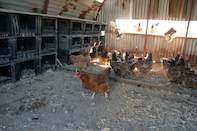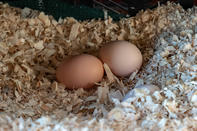Before buying birds or any equipment, you need to identify your target market, what the market wants, what it is willing to pay and the cost of producing this product.

You also need to familiarise yourself with the rules and regulations that the products would have to comply with. The best, as with any other agricultural enterprise, is to secure a market before starting production. Egg producers may produce their own layers (that is what you call chickens that lay eggs) or buy these birds at point of lay at the age of 18 to 19 weeks depending on the breed.
(Birds are called pullets between the time they are hatched up until they are ready to produce eggs). It makes sense to buy the birds in if the operation size will be large, as raising chicks is quite difficult and the chicks needs to receive balanced diets to ensure they will be able to produce lots of good quality eggs.
Point of lay chicks should also have been vaccinated against the most important diseases. Layers on average, depending on the breed, the birds’ diets and climatic conditions, produce an egg a day. Commercial hybrid layers, for example, produce significantly fewer eggs under hot humid conditions than under temperate climates.
Eggs are small at first but gradually increase in size. The number and quality of the eggs produced will peak halfway through the production cycle and then tail off.
Small-scale farmers or farmers who keep scavenging birds that does not have high feeding costs, might decide to keep the birds for another production cycle. In intensive production systems, however, the birds are sold to hawkers when it makes more financial sense to replace the birds, usually from the 69th week of production.
Types of Marketing
Egg producers may sell their eggs directly from the farm, from door to door or via street hawking, producer markets or retailers. Doing the marketing yourself may make economic sense if you have a small operation, but it might become too time consuming resulting in a producer having less time to spend on the production side if the operation is bigger.
Transportation, packaging and branding might also increase costs. Alternatively producers may use market intermediaries, who typically collect eggs on a commission basis or for their own account, and then sell the eggs at local markets, to wholesalers, retailers, restaurants, hotels, hospitals and so forth.
These collectors may be travelling merchants, market agents, independent processor-packers or producers themselves. It might be a good idea to start a cooperative processor packing company in areas where there is a group of farmers producing eggs.
The main advantage of this is that the cooperative will have the farmers’ best interest at heart, as it is run by and for those who use it, rather than those who own it.
Egg Quality

Each market will have its own preferences, control restrictions or minimum standards as well as packaging and disease controls. It is not only size and quality that matters, but some markets even prefer eggs with a specific shell or yolk colour.
Nobody in South Africa may sell eggs for human consumption unless the eggs comply with South African legislation.